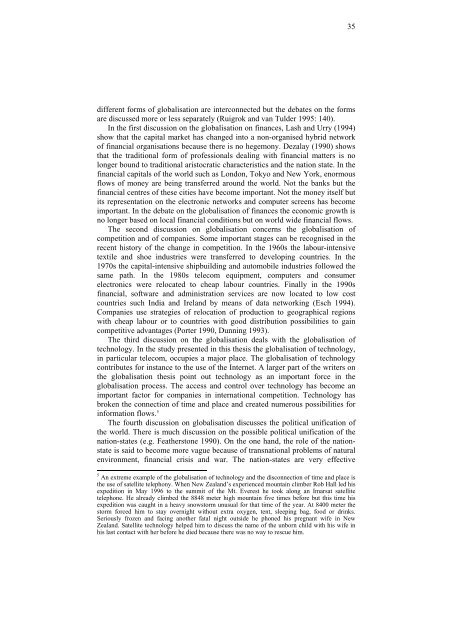The Internationalisation of PTT Telecom: A Cultural Perspective - Free
The Internationalisation of PTT Telecom: A Cultural Perspective - Free
The Internationalisation of PTT Telecom: A Cultural Perspective - Free
- No tags were found...
Create successful ePaper yourself
Turn your PDF publications into a flip-book with our unique Google optimized e-Paper software.
35different forms <strong>of</strong> globalisation are interconnected but the debates on the formsare discussed more or less separately (Ruigrok and van Tulder 1995: 140).In the first discussion on the globalisation on finances, Lash and Urry (1994)show that the capital market has changed into a non-organised hybrid network<strong>of</strong> financial organisations because there is no hegemony. Dezalay (1990) showsthat the traditional form <strong>of</strong> pr<strong>of</strong>essionals dealing with financial matters is nolonger bound to traditional aristocratic characteristics and the nation state. In thefinancial capitals <strong>of</strong> the world such as London, Tokyo and New York, enormousflows <strong>of</strong> money are being transferred around the world. Not the banks but thefinancial centres <strong>of</strong> these cities have become important. Not the money itself butits representation on the electronic networks and computer screens has becomeimportant. In the debate on the globalisation <strong>of</strong> finances the economic growth isno longer based on local financial conditions but on world wide financial flows.<strong>The</strong> second discussion on globalisation concerns the globalisation <strong>of</strong>competition and <strong>of</strong> companies. Some important stages can be recognised in therecent history <strong>of</strong> the change in competition. In the 1960s the labour-intensivetextile and shoe industries were transferred to developing countries. In the1970s the capital-intensive shipbuilding and automobile industries followed thesame path. In the 1980s telecom equipment, computers and consumerelectronics were relocated to cheap labour countries. Finally in the 1990sfinancial, s<strong>of</strong>tware and administration services are now located to low costcountries such India and Ireland by means <strong>of</strong> data networking (Esch 1994).Companies use strategies <strong>of</strong> relocation <strong>of</strong> production to geographical regionswith cheap labour or to countries with good distribution possibilities to gaincompetitive advantages (Porter 1990, Dunning 1993).<strong>The</strong> third discussion on the globalisation deals with the globalisation <strong>of</strong>technology. In the study presented in this thesis the globalisation <strong>of</strong> technology,in particular telecom, occupies a major place. <strong>The</strong> globalisation <strong>of</strong> technologycontributes for instance to the use <strong>of</strong> the Internet. A larger part <strong>of</strong> the writers onthe globalisation thesis point out technology as an important force in theglobalisation process. <strong>The</strong> access and control over technology has become animportant factor for companies in international competition. Technology hasbroken the connection <strong>of</strong> time and place and created numerous possibilities forinformation flows. 5<strong>The</strong> fourth discussion on globalisation discusses the political unification <strong>of</strong>the world. <strong>The</strong>re is much discussion on the possible political unification <strong>of</strong> thenation-states (e.g. Featherstone 1990). On the one hand, the role <strong>of</strong> the nationstateis said to become more vague because <strong>of</strong> transnational problems <strong>of</strong> naturalenvironment, financial crisis and war. <strong>The</strong> nation-states are very effective5 An extreme example <strong>of</strong> the globalisation <strong>of</strong> technology and the disconnection <strong>of</strong> time and place isthe use <strong>of</strong> satellite telephony. When New Zealand’s experienced mountain climber Rob Hall led hisexpedition in May 1996 to the summit <strong>of</strong> the Mt. Everest he took along an Imarsat satellitetelephone. He already climbed the 8848 meter high mountain five times before but this time hisexpedition was caught in a heavy snowstorm unusual for that time <strong>of</strong> the year. At 8400 meter thestorm forced him to stay overnight without extra oxygen, tent, sleeping bag, food or drinks.Seriously frozen and facing another fatal night outside he phoned his pregnant wife in NewZealand. Satellite technology helped him to discuss the name <strong>of</strong> the unborn child with his wife inhis last contact with her before he died because there was no way to rescue him.




